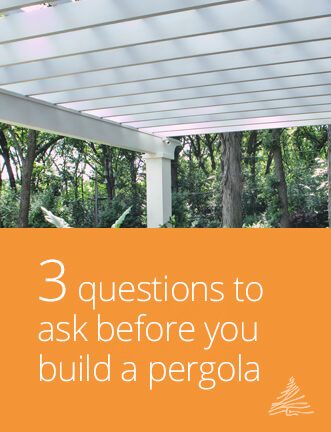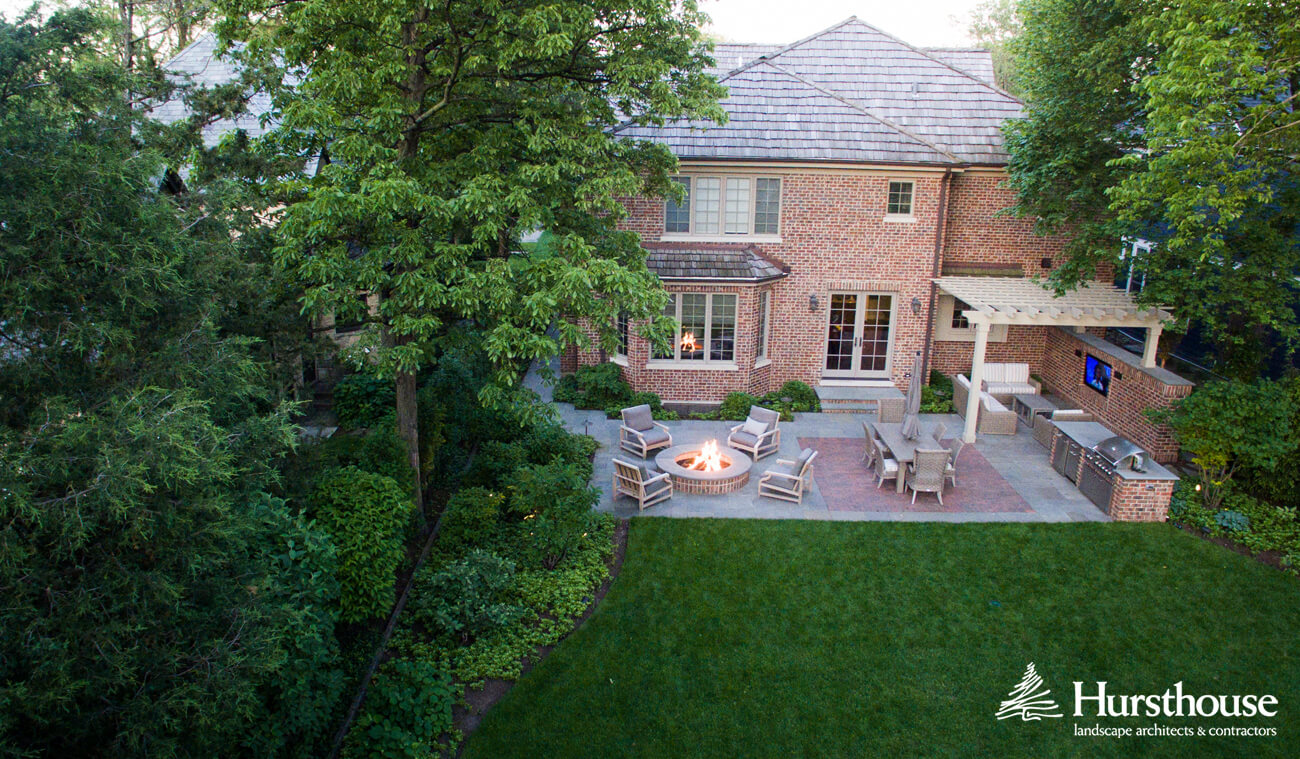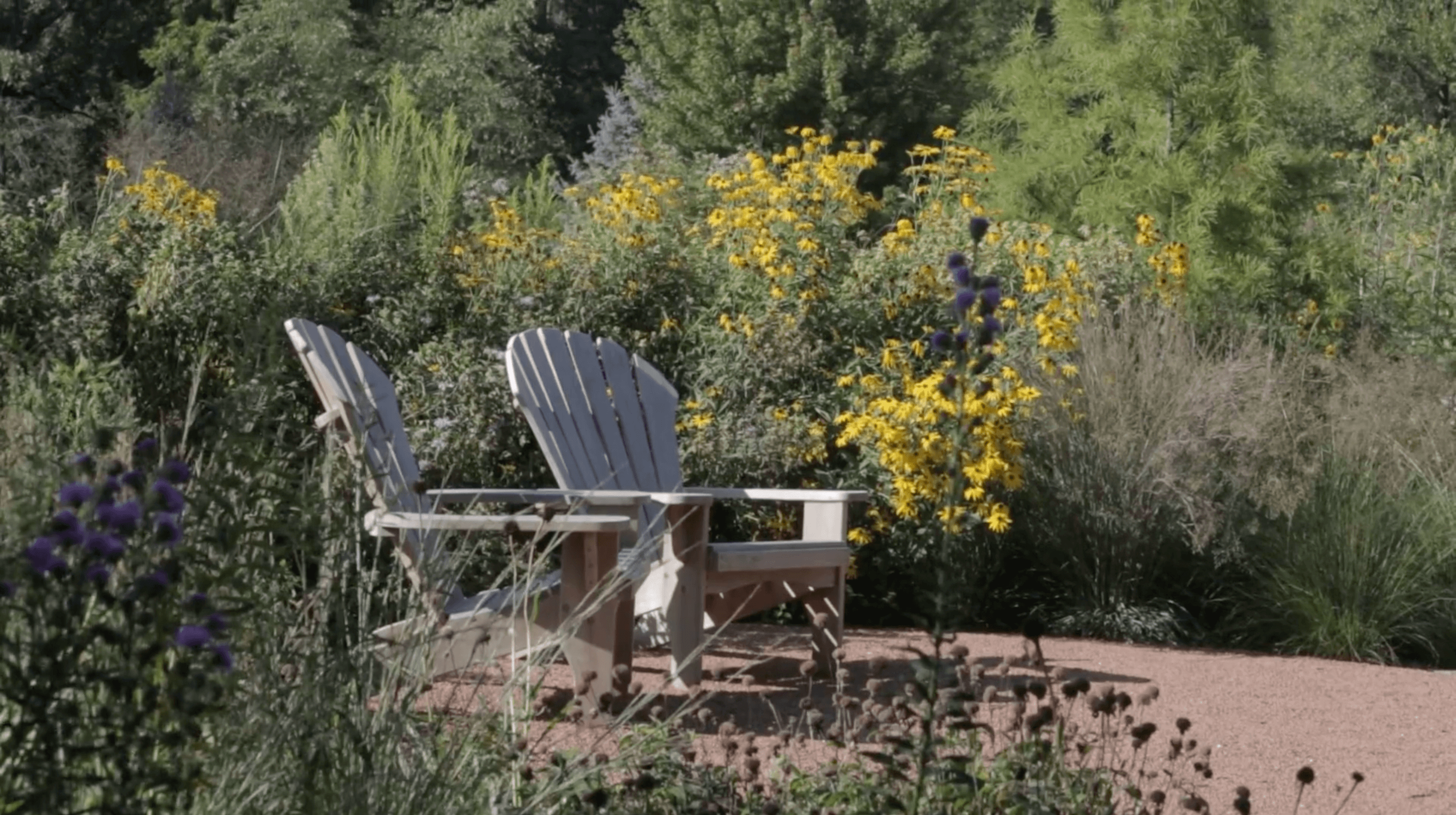Many gardens remind us of their counterparts indoors—a living room, dining room or kitchen. The garden typically has a floor, walls and a ceiling made with plants and hardscape elements—things like pavers, decks, arbors and fences. Ground covers, such as hostas and ferns or coneflowers and catmint, along with the lawn, serve as the garden’s carpet or floor. Evergreen shrubs—yews, boxwood or arborvitae—become the walls. And, large shade trees with arching branches create the ceiling.
An essential part of the Hursthouse design process is analyzing the views into the spaces surrounding the home. “We’re constantly looking at which views we need to capture,” says Jeff True of Hursthouse. “We also look at what we need to screen.”
A view onto a neighbor’s utility area is just one example that could be screened with a fence, wall, trellises or shrubs. Vertical elements work in urban gardens where space is at a premium as well as sprawling suburban gardens.
Plants
Many new varieties of plants have been developed for tight, narrow spaces. Columnar trees—narrow but tall—are useful in confined areas. Some examples include Darwyk’s purple beech, columnar English oak, and Green Giant arborvitae. Some plants have the word “fastigiate” in their name or description. Fastigiate simply means tall and thin.
Fastigiate plants add a very desirable vertical line to the landscape. Besides working as a screen, they can be used as a single specimen plant to provide a visual pop in the garden. A line of tall, narrow plants can be formal and elegant in the right setting.
Focal Points
For a small urban garden, Hursthouse added a large, custom trellis in front of a nondescript, detached garage and covered it with a climbing hydrangea. The vine-covered trellis provides something unique to look at from within the garden as well as from inside the house. Instead of a blank wall, the homeowners now have an interesting planted structure they enjoy.
“Oftentimes we’ll plant two different kinds of vines,” True said. “We might pair Virginia creeper, a vine that will establish quickly, with a climbing hydrangea or clematis, both of which are slower-growing vines. A lot of this is client-driven and how important the screening is and how long they’re willing to wait for it.”
Vertical elements are very useful in narrow planting beds where it’s difficult to get height and coverage with shrubs. “A wood or metal trellis may become the vertical element,” True said. “I love wall trellises and vines and they don’t take up much space.” In some back yards with limited space, they may only have a two-foot deep planting bed around a deck, patio or foundation. “That’s a perfect opportunity to get height in that space.”
Another technique, called espalier, is training plants to grow in a flat plane along a trellis, wall or fence. “Espalier is created by taking a young plant and training it to be very linear,” True explained. “We can espalier an apple tree and by pruning the roots and the top, we can get it to grow along a wall or a fence. It’s a very unique and outstanding look.”
Architectural Cues
For most projects, the Hursthouse design team creates custom features with specific details to complement the architecture. In some cases, the design team may create a wall as the vertical element. “We go back to the house to determine the material palette,” True said. If stone is used on the house, they may build a stone wall. The same goes for brick. In some instances, they may choose a metal fence that allows a view between the posts rather than a solid wall. “We determine what percentage of openness we want for the site lines,” True said.
An attractive garden element could be a great wall trellis, a raised planter or a full structure that has depth and height like a pergola or arbor. “Take the little blank part of a wall between two windows. We’ll look at that and think about how to use a beautiful wall trellis in that spot that highlights the architecture of the house.”
When designing with wood lattice, True thinks outside the big box stores, which offer inexpensive, short-lived lattice panels. “Most people think of lattice with the angled 45-degree grid, but it could be vertical and horizontal with really close strips a few inches apart for each board. When we determine the spacing it depends on if we’re growing a vine on it and the density.” For screening purposes, a trellis panel may be built with the boards closer to one another or the structure can be airier for the vines to scramble on both sides.
In some instances, Hursthouse may use an ornamental standalone panel to screen a view. “We’ll also look at where else we can place another panel in the garden, so it looks intentional and so that the one screening the view doesn’t stick out. Now we have balance and unity by using multiple similar elements.”
When the Hursthouse design team is creating a wall trellis for the house, they look at the windows for design cues. “We may create the trellis grid to match the window’s mullion bars, or we might paint it to match the window trim.” Leaded glass or a mirror might be part of the trellis design.
A pergola placed over a patio is another way to create vertical interest in the garden. Pergolas are simply extended arbors and can be used to shade a seating area as well as support flowering vines.
Materials
Panels used as a screen can be a traditional fence or lattice panel between two posts. Decorative metal grids can also be used between two posts. “Some of the panels can be planted and they look like living walls.”
Corten steel panels with cut-out designs offer a contemporary vibe. “They can be any design you want,” True said. “We also design planter boxes and privacy screens with this material. They’re cut to size and welded together.” Some steel panels take on a weathered patina over time. Others made from stainless steel offer a bright polished look.
A mirror or a piece of outdoor art, such as a painted canvas that resists sunlight, can be hung on a wall to draw the eyes upward. “It creates interest on a vertical plane. Just about anything you can think of used inside the home can be used outside. There are floor lamps designed for outdoor use.”
The Light at Night
Vertical garden elements benefit from lighting at night. Fountains or trees lit up from below cast fascinating shadows any time of the year. “Some of the most dramatic lighting comes from these vertical elements,” True said. “We’ll place light at the ground, so it grazes up the face of the element whether it’s a wall, a fence or tree. You’ve got darks and lights and texture of the feature itself at night. It makes for a fascinating landscape.”


